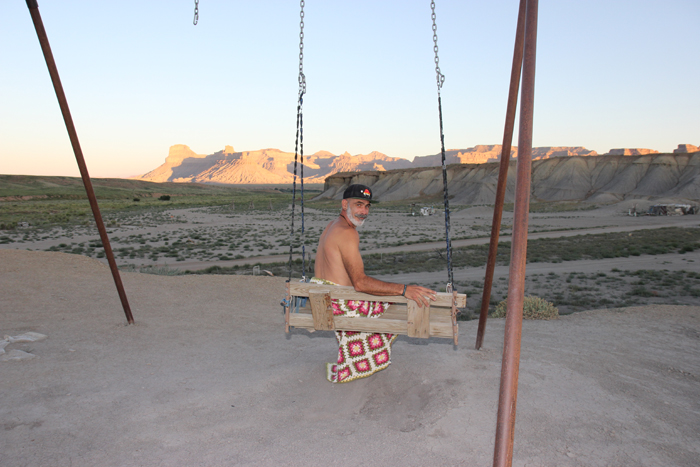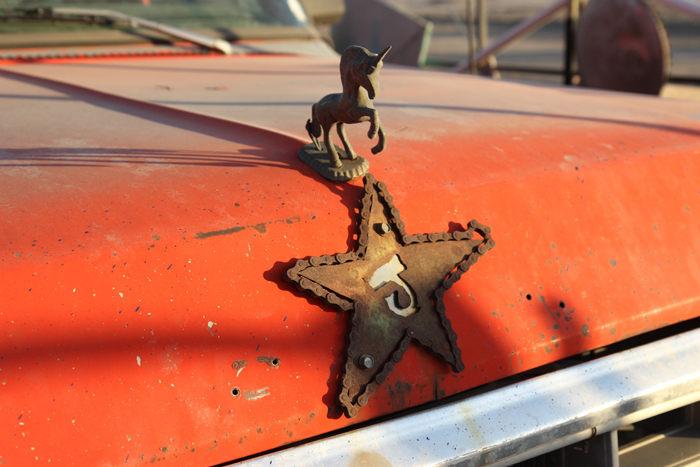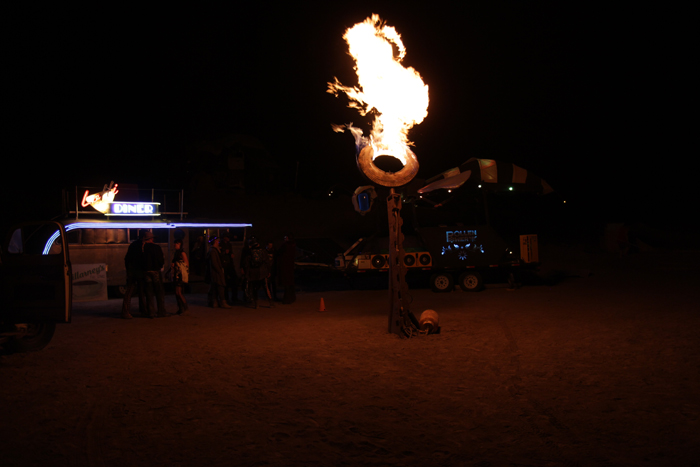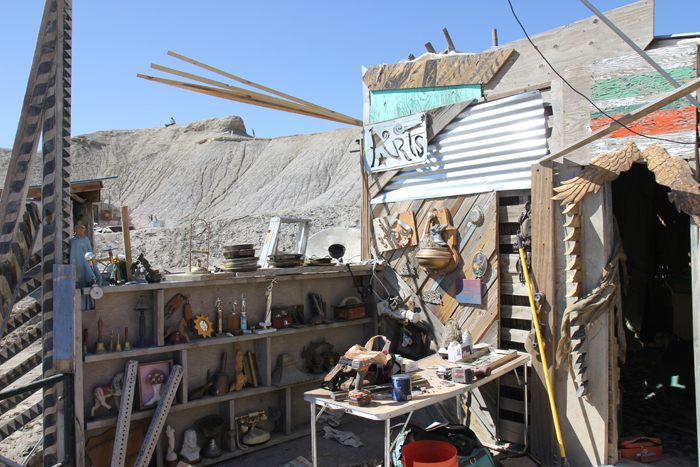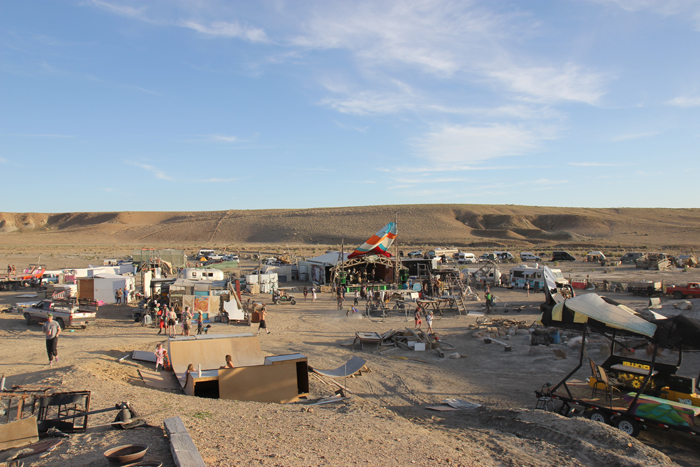Building Man, an annual, week-long desert rave and art festival in Green River, Utah, celebrates artists who work with found and reclaimed materials.
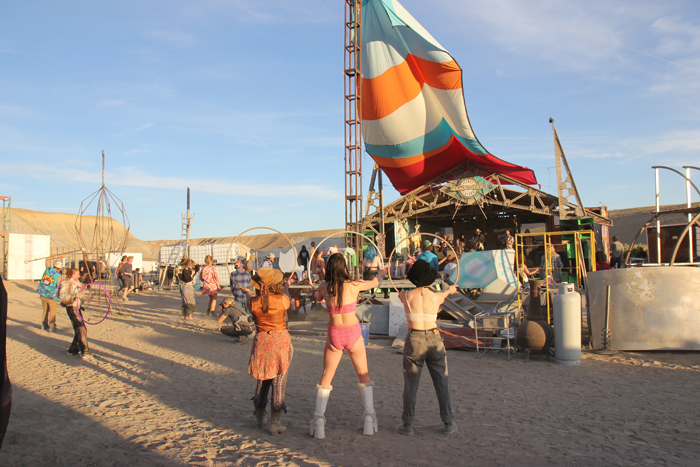
I did not notice the tears welling in Scotty Whitaker’s eyes toward the end of our interview. He was wearing sunglasses, sporty and of the gas station variety. All I could see when I looked for his eyes behind his oil-slick lenses was the reflection of my own face, flushed in the heat and dulled by a hangover. I was reporting on Building Man, an annual, week-long desert rave and art festival in Green River, Utah, for work. But surely I had to partake in the party to fully capture its essence, no?
In any case, at one point, Whitaker, Building Man’s founder and grand orchestrator, was telling me about his dust collection, and he was crying. “I didn’t think that would make me so emotional,” he said afterward, rubbing his eyes with thumb and forefinger.
I harp on this detail only because I was surprised, and therefore touched. Whitaker, alias Scotty Soltronic, is mustached and gruff and tanned from a lifetime under the Utah sun. Every time I saw him that weekend, he had an entourage of young women in his wake. In my memory, he is very tall, though in truth, he is probably average or slightly-above-average height. He drives big trucks around his desert ranch, and he builds big things with his hands. In other words, he leans into a kind of machismo swagger that makes his tender reverence for sawdust noteworthy and endearing.
“I can’t just throw stuff away,” says the fifty-year-old artist and owner of the JenkStar Ranch, a swath of shale desert in southeastern Utah where Building Man has taken place for fifteen years. Whitaker’s artistic practice is dedicated to transforming trash into sculpture. He takes recycling very seriously. Even the dust left over from a metal cutting is repurposed.
We were talking about catching the magic, summoning the muse, whatever that inexplicable moment is when the artist suddenly knows, when he finally goes. For Whitaker, that state of being starts with getting organized.
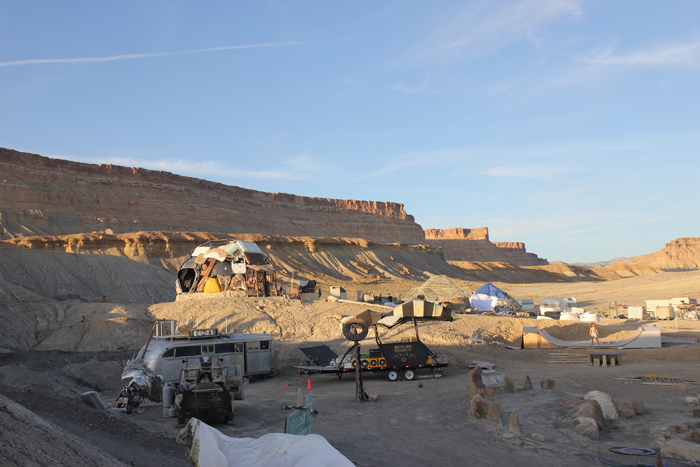
“I go through hours of sorting,” he says, referring to the metal scraps he often works with. “Circles go here. Squares go here. Triangles go here. I do that down to the smallest metal shavings and filings. I sweep them up with a magnet, and I sift them down until I get the finest powder of my work. I have jars and jars of this powder. For me, it represents the effort and the magic.”
Sometimes, when he finishes a piece, he drizzles a little bit of motor oil on the final product then sprinkles the powder in the oil. “Doing that, it’s like saying, ‘I love you,’” he says. “It’s a weird thing. It never dries. It gets all over you and in your house. People are always like, ‘What is that?’ and I’m like, ‘That’s actually really special. Don’t touch that.’”
“Jenk” is junk, but art. “Jenk is anything that’s broken beyond repair that’s been made into something else,” Whitaker says. The JenkStar Ranch is home to dozens of his and other artists’ scrap-metal assemblages. Lots of them were built on-site during past Building Man festivals. Every year, new structures are added to the property. This year, a sauna and not one but two tattoo studios were constructed.
Permanent fixtures of the ranch include a main stage, a geodesic dome made from car doors and hoods, a tea house, a sunken pirate ship, a few buildings that function as storefronts during events, and an RV where Whitaker stays when he is at the ranch—his permanent residence is in Park City.
Some rigs were brought in just for the festival, such as a mobile stage in the style of a flying saucer and an old truck with a horn that triggered a gas line that ignited a tire sculpture when “honked.” Whitaker says this year was the largest Building Man to date with 800 attendees.

One of this year’s main attractions was the construction of a hemp-brick dome, a collaborative and educational process led by Stephen Clarke, a natural builder who co-founded an organization called Heavengrown.
“What we’re doing here is showing people how they can grow their own homes,” said Clarke. “We don’t use any power tools. We just work with our hands and the earth. We’re using all materials that can be found in the landscape—hemp, clay, lime.”
The name “Building Man” is a reference to Burning Man, an annual festival held in the Black Rock Desert of Nevada during which artists construct a temporary city for nine days—80,000 people attended in 2022. On the penultimate night, they burn an effigy, the Man.
I can’t just throw stuff away.
Burning Man started in 1986 as a haven for countercultural expression and as an experiment in community-building. Today, some argue that the festival has strayed from its original intentions. The event is heavily attended by social media influencers—the death knell of any countercultural movement—a point that Burning Man’s CEO Marian Goodell made in a 2019 press release when she banned certain high-profile Burners from the festival.
Quite a few Building Man participants I talked to had been to both events. Jesse with the jenked-up Polaroid rig—he would not tell me his last name, in the spirit of anonymous rave culture—is a self-described “old-school Burner.”
“Building Man is kind of like early Burning Man,” he said. “It’s like Burning Man with fewer rules.”
Unchaperoned is how I would describe the atmosphere at Building Man, though not necessarily chaotic. It felt childlike and liberating. The organizers take a “safety third” approach, as stated in the Building Man Survival Guide that was emailed to ticket holders. On the suggested packing list: “A tetanus shot—yeehaw.”
•
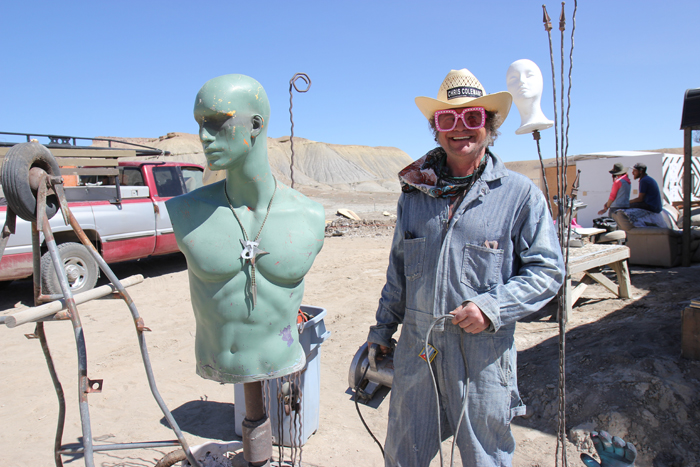
Chris Coleman, an artist from Marysvale, Utah, and a long-time Building Man participant, was cutting metal sheriff stars when I met him. Each star had a little J on it. “I’m creating JenkStar badges, so people can get deputized,” he said.
I asked him what it took to become a Deputy JenkStar. “I’m not sure there are any rules,” he laughed. “Just a willingness to participate. Jenking is all about making art out of found objects, assemblage. Sky is the limit.”
Around the base of his straw cowboy hat, he had a band of woven beer tabs. He saw me looking at it. “I don’t drink anymore, but I still got the beer tabs because I just couldn’t throw them away,” he said. “You’ll notice we don’t have any trash cans out here. Everything’s useful for something.”
I asked him where he thought the genre of jenk came from. “Probably has roots in Americana art,” he said, but did not elaborate. If Americana is kitsch, and kitsch is nostalgia, and nostalgia fuels the compulsion to hoard, then perhaps jenk is Americana.
More specifically, I would say jenk is distinct to Western Americana. Old cars feature heavily in jenk sculptures, and likewise in the iconography of this region. And by nature of its weathered materials, jenk lends the illusion of history, even if the assemblage is new. This activates within the viewer a pre-programmed sense of romance about a bygone America, even if that America is a myth.
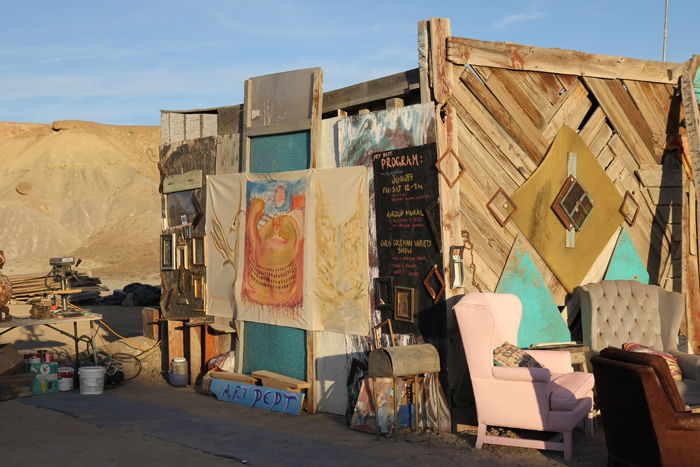
More straightforwardly, jenk is common in the deserts of the American West because there is a lot of trash here. The expanse of empty land behind one’s house is as good a place as any to store generations of accumulated junk. And the dry heat of the desert preserves that junk immaculately.
Anyone who lives here knows that materials are scarce, a fact that inclines many to stockpile. That busted Ford that has been in the yard since before you were born will never run again, but how could you throw it away when you never know when you might need it for parts? Quantity gets mixed up with value. Enough of anything is worth something, so let’s keep it all.
But Whitaker makes jenk not because he has to, not because junk is the only material available to him. He makes jenk because junk speaks to him, sometimes literally.
“There’s an energy inside of everything,” he says. “As an artist, I’m always trying to listen to what the material is saying.”
He could be crazy. But I believed him when he talked about dialing in to this channel of nonhuman communication. I believed him when he told me the story of when he met the Wind Spirit of Green River because I have also met this spirit in the delirium of summer when the gusts roll through town with such force, they collect enough dust to blot out the sun.
By nature of its weathered materials, jenk lends the illusion of history, even if the assemblage is new. This activates within the viewer a pre-programmed sense of romance about a bygone America, even if that America is a myth.
He first met this spirit at the JenkStar Ranch in 2012 when he was hosting Desert Rocks, a music festival that usually takes place in Moab. At one point, he said the wind was blowing a steady forty-six miles-per-hour with gusts up to seventy-six miles-per-hour.
Most of the festival’s 4,000 attendees left. But Whitaker stayed behind and stood under one of his sculptures, a fourteen-foot arch with a metal angel mounted to the top.
“I was worried it was going to come crashing down on someone,” he said. “I stood there for about an hour, and I was staring up at this angel. She had these metal wings I made from a car hood. I could barely see with all the dust. But I could hear her wings flapping so hard in the wind. They were making this screeching sound, like a witch.”
“I had this moment with the wind spirit where she was like, ‘I could kill you right now. I could blow you off this Earth,’” he said. “But she didn’t. But she was reminding me who was in charge.” Eventually, the wind died down, and the angel gave Whitaker her blessing. “She was like, ‘Pay attention to what you’re doing, but you’re doing a good job.’”
•
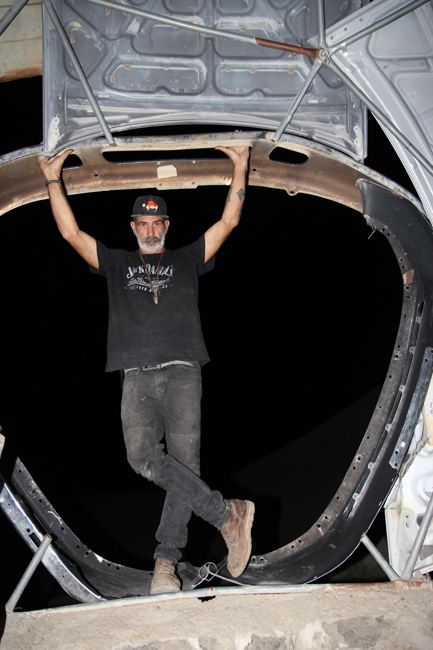
“At any moment in time, just go dip your hand in the river of shit that’s pouring out of the human species,” said Whitaker. “That’ll teach you anything you want to know about people.” I would argue that watching ravers let loose in the desert can also teach you anything you want to know about people.
Building Man is not only a demonstration in the transformative power of art to create meaning out of refuse. More evidently, I would say it is an example of the transformative power of a good party to course-correct one’s personality.
Like the trash pickers many of them are, I watched Building Man’s revelers dig around in the dumping grounds of their inner worlds and unearth their festering and rotten impulses. More explicitly, I watched people get really high, saw their eyes glaze over and their jaws get tight, watched them strip down and dry hump on the dance floor, saw one guy flog another with a scourge, had one guy stick his tongue out at me and then crawl between my legs, and when I saw these people the next day, they were bleary-eyed but glowing in the comedown of the bacchanalian purge.
During our interview, Whitaker described the trance-state he achieves when he converses with his materials before starting a piece. “I go somewhere,” he said. “I get a little manic. I look a little crazy.” Perhaps this is the throughline at Building Man that connects the revelers with the artists—all seek to achieve that state of transmutation when the body becomes a vessel for change, whether by partying or talking to trash.
•
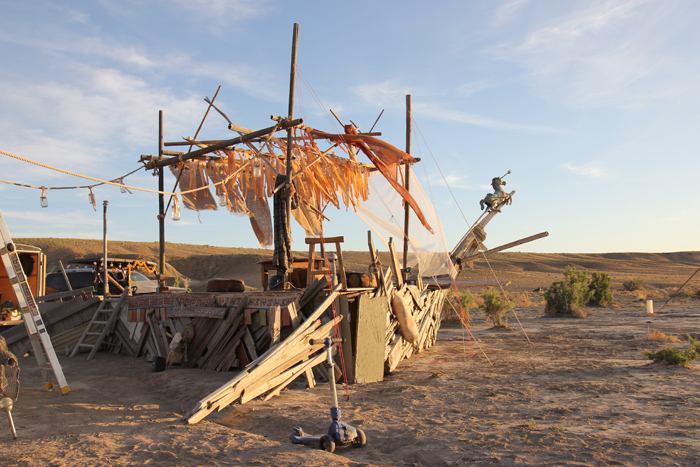
About a week after meeting Whitaker, I had a bout of sleep paralysis, a horrifying hallucinatory state I had not experienced in years. It was early dawn, and I was frozen in my bed. My eyes were open, and among the familiar surroundings of my bedroom was Whitaker. He approached me, then bent over my paralyzed body and said: Let me be. When I came to, Whitaker vanished, as the figures always do.
I was deeply unsettled the next morning. Did he so urgently want me to leave him alone that he felt like he had to traverse the highways of my subconscious to deliver that message? I know very little about astral projection, but I do know that Whitaker is at least somewhat practiced in the art of dream-travel—someone interrupted our interview at Building Man to remind him that he was late to the lucid dreaming workshop he was meant to teach.
The sleep paralysis gave me a bad feeling about writing this article. But after a few days of reflecting on the message, I realized that let me be is meaningfully different from leave me alone. And so, Whitaker, if you are reading this: I want to say that I hope I let you be. I hope the mirror I held up for you is clear and true and captures the angles you know so well. If I have done my job effectively, perhaps I even caught some angles you could not see alone.

